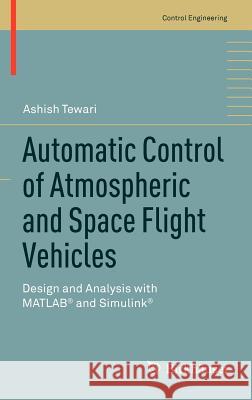Automatic Control of Atmospheric and Space Flight Vehicles: Design and Analysis with Matlab(r) and Simulink(r) » książka
Automatic Control of Atmospheric and Space Flight Vehicles: Design and Analysis with Matlab(r) and Simulink(r)
ISBN-13: 9780817648633 / Angielski / Twarda / 2011 / 374 str.
Automatic Control of Atmospheric and Space Flight Vehicles: Design and Analysis with Matlab(r) and Simulink(r)
ISBN-13: 9780817648633 / Angielski / Twarda / 2011 / 374 str.
(netto: 422,69 VAT: 5%)
Najniższa cena z 30 dni: 424,07
ok. 22 dni roboczych
Bez gwarancji dostawy przed świętami
Darmowa dostawa!
Automatic Control of Atmospheric and Space Flight Vehicles is perhaps the first book on the market to present a unified and straightforward study of the design and analysis of automatic control systems for both atmospheric and space flight vehicles. Covering basic control theory and design concepts, it is meant as a textbook for senior undergraduate and graduate students in modern courses on flight control systems. In addition to the basics of flight control, this book covers a number of upper-level topics and will therefore be of interest not only to advanced students, but also to researchers and practitioners in aeronautical engineering, applied mathematics, and systems/control theory.
Perhaps the only full publication to present a unified and straightforward introduction to the design and analysis of automatic control systems for both atmospheric and space flight vehicles, Automatic Control of Atmospheric and Space Flight Vehicles is intended to be a textbook for senior undergraduate and graduate students in aerospace engineering/aeronautics and astronautics departments. Covering basic control theory and design concepts, the material in the book has been specifically developed for a modern course on flight control systems, where the artificial distinction between aircraft, rockets, and spacecraft is removed. A wide variety of flight control topics are presented in a concise and easy-to-read yet rigorous manner. §The book highlights an understanding of relevant flight dynamic principles required for designing a flight control system, placing specific emphasis on a wealth of realistic examples and exercises that require programming. A particularly appealing feature of the text is the ready and extensive use of MATLAB®/Simulink® codes in the many solved examples illustrating flight control design and analysis; these examples give the reader hands-on experience with practical problems and make the book an even more useful and illuminating tool. For convenience, all the codes used can be downloaded from the author's and publisher s websites. Moreover, selected exercise solutions are provided in the text, and a full solutions manual is available to instructors online.§The coverage of flight control topics in the book is fundamental rather than exhaustive, with a greater emphasis on single-variable control for a strong understanding of the relevant concepts. The work may therefore be used for a first course on flight control systems. However, it also covers some advanced topics such as linear optimal control, nonlinear orbit plane control, and two-point boundary value problem solution for de-orbiting spacecraft imparting a flavor of the variety found in automatic flight control, and will be of interest to experienced researchers and practitioners in aerospace and control engineering.











